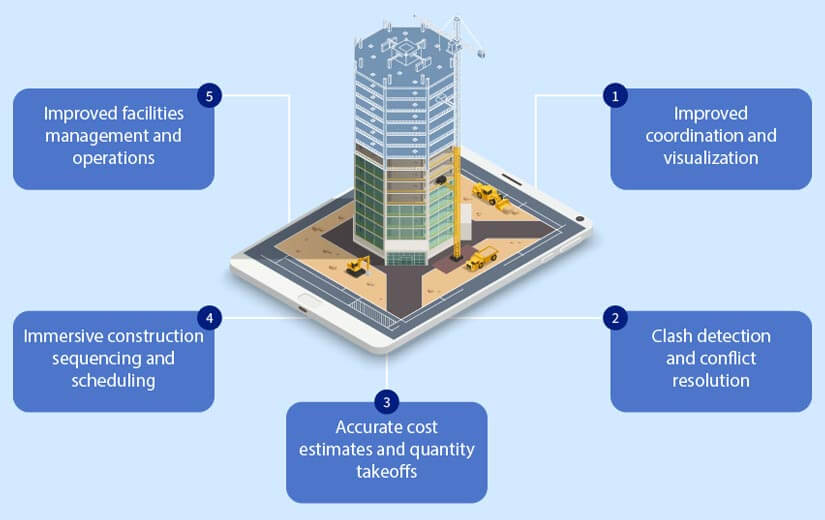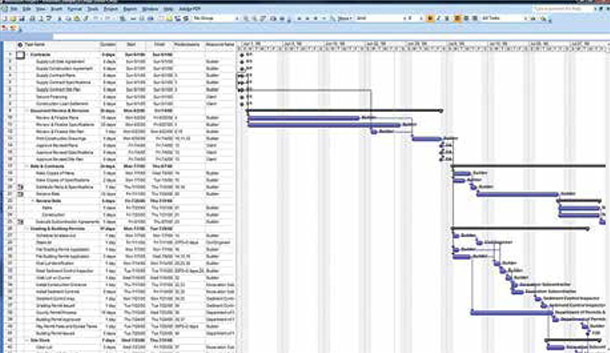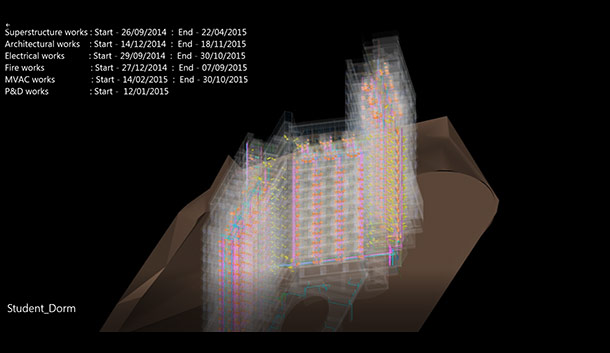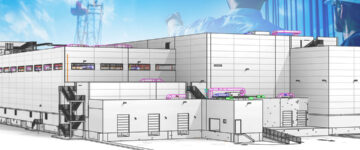- BIM has revolutionized architectural design, transforming it from static 2D drawings into a dynamic and collaborative 3D space, making the entire building process more seamless.
- Legacy architectural workflows are often surrounded by inefficiencies and complexities that lead to errors, miscommunication and costly delays.
- Architectural BIM services address these obstacles, facilitating efficient collaboration, improving project visualization, and reducing risks for the entire building project.
Working with the right Architectural BIM services provider is vital for project success. Their expertise and experience ensure precise 3D modeling, clash detection, and seamless coordination, leading to enhanced design, mitigated errors, and optimized workflows.
Architectural BIM services support is essential for modern construction project stakeholders. The centralised platform facilitates improved communication and collaboration. Based on a single source of truth, the 3D BIM model delivers real-time collaboration and reduces miscommunication between architects, engineers, contractors and clients.
Table of Contents
- Defining Architectural BIM Services
- Top 5 benefits of architectural BIM modeling
- Top 10 tips in selecting architectural BIM services for buildings
- Assess project needs
- Research and identify experienced BIM service providers
- Evaluate required BIM software
- Consider portfolio and past projects
- Check for accreditations and certifications
- Analyze communication and collaboration channels
- Take into account budget and pricing
- Verify expertise with testimonials and client references
- Evaluate after-sales and customer support
- Conduct self-evaluation using an instinctive approach
- Future of architectural BIM services with AI and ML-driven tools
- Conclusion
Moreover, BIM creates immersive 3D visualizations that allow stakeholders to better grasp design intent and flag clashes or conflicts in the preconstruction stage. By utilizing Architectural BIM services aids in quantity takeoffs and construction sequencing simulations, stakeholders can ensure fewer errors, reduced rework, and improvements in construction schedules. Furthermore, data-driven decision-making for the complete project lifecycle improves design, sustainability and overall project results.
In this article, we have explored the nature of Architectural BIM services and their benefits. We have discussed the 10 key factors to consider while selecting an Architectural BIM services provider, as well as the future of Architectural BIM, highlighting the integration of AI and ML technologies.
Defining Architectural BIM Services
Architectural BIM services involve the generation and management of 3D models that encompass a building’s physical and functional characteristics. These accurate and data-rich 3D models enable capabilities like clash detection, data-driven decision-making, collaboration and visualization throughout the design, construction and operations stages of a building project.
Top 5 benefits of architectural BIM modeling

Improved coordination and visualization
BIM creates accurate, data-rich, immersive 3D models that deliver a detailed visualization of the building design. This improves the understanding of spatial relationships, material selection, and design intent for all participants, leading to informed decision making.
Clash detection and conflict resolution
BIM enables interference detection through tools like Navisworks between various trades, including architecture, structure and MEP within the unified 3D model. This supports early issue identification and resolution, minimizing reworks during construction.
Accurate cost estimates and quantity takeoffs
Detailed information within BIM models enables precise material estimates and cost forecasting, which improves resource allocation and project budgeting.
Immersive construction sequencing and scheduling
BIM facilitates the creation of 4D simulations by linking the 3D model with construction schedules. This allows for the visualization of construction sequences and the identification of bottlenecks, and leads to improvements in project timelines.
Improved facilities management and operations
BIM data can be used for the entire building lifecycle to enable effective facility management. Information on asset management, energy performance, and space utilization can be accessed from the BIM model, which reduces costs and streamlines operations.
Leveraging BIM for energy analysis in projects can lead to a 30% reduction in energy consumption.
Source: medium.comOutsourcing 4D BIM scheduling accelerated the completion of a US student dorm project by 4 weeks.
 Planned construction schedule
Planned construction schedule
 Snapshot of construction sequence
Snapshot of construction sequence
An architectural firm reached out to HitechDigital for a dormitory project for a US university to improve their BIM model with capabilities such as the simulation of construction activities and timeframe visuals. To tackle challenges in coordinating work progress and resource allocation, HitechDigital leveraged Navisworks to generate a 4D BIM scheduling video. This visualization significantly improved project clarity, fostered collaboration and enabled efficient resource management. Construction scheduling and Sequencing based on 4D BIM enabled:
- Accelerated project completion by 4 weeks
- Provided insights into project progress and enabled precise resource management
- Led to seamless monitoring of activities on the construction site
Overwhelmed by project complexities and coordination challenges?
Streamline your project and eliminate design conflicts to ensure seamless construction.
Top 10 tips in selecting architectural BIM services for buildings
Working with an ideal architectural BIM service provider requires significant consideration. Prioritize project requirements, research experienced service providers, evaluate software interoperability, assess past projects, and check for industry-backed certifications. Efficient communication, cost considerations and client testimonials are crucial for a successful working partnership.
1. Assess project needs
Before starting the selection process, it is imperative to gain a thorough understanding of your specific BIM project needs. Consider the project’s complexity, size and required level of detail (LOD) within the BIM model. Identifying key objectives such as energy analysis, clash detection, and facilities management will help clients navigate the selection process for the right capabilities and expertise.
Outcomes
- Targeted provider search
- Clear project scope
- Efficient communication
- Improved project outcomes
- Enhanced service selection
2. Research and identify experienced BIM service providers
Conduct in-depth research to identify architectural BIM services providers that possess a proven track record in handing over successful and high-quality deliverables and projects. Identify firms with expertise in various project types and industries. Explore digital assets like websites, online catalogs, and client feedback to gain insights into their skills, experience and reputation.
Outcomes
- Reputation check
- Client satisfaction assessment
- Insights into project performance
- Shortlisting of qualified providers
- Understanding provider specialties
3. Evaluate required BIM software
Ensure the service provider uses software that is compatible with existing workflows and systems. Compatibility makes data exchange and collaboration seamless, reducing disruptions and potential issues. Moreover, verify that the provider is updated with the latest software versions and adheres to industry best practices.
Outcomes
- Efficient collaboration
- Streamlined data exchange
- Reduced errors and rework
- Increased productivity
- Future-proofing
4. Consider portfolio and past projects
Review past projects and the provider’s portfolio to analyze capabilities and experience. Look for projects similar in complexity and scale, and pay attention to the precision, Level of Detail, and overall quality of the 3D BIM models. This will provide a good indication of their ability to meet the required project needs.
Outcomes
- Insights into technical proficiency
- Quality assurance
- Compatibility check
- Understanding project complexities
- Confidence within their capabilities
5. Check for accreditations and certifications
Certifications and accreditations showcase a service provider’s commitment to work quality and adherence to industry standards. Look for certifications from reputable firms like the American Institute of Architects, as these certifications provide assurance of the provider’s knowledge and skills in providing high-quality BIM services.
Outcomes
- Demonstrated commitment to quality
- Credibility and trustworthiness
- Adherence to industry standards
- Assurance of skills
- Increased confidence in service quality
Want to minimize errors and get seamless construction?
Simplify workflows with improved visualization and sustainable design practices.
6. Analyze communication and collaboration channels
Effective communication and collaboration are essential for successful BIM implementation. Evaluate the BIM service provider’s communication channels and collaboration platforms to ensure seamless data exchange with regular updates and expedited issue resolution.
Outcomes
- Clear expectations
- Real-time collaboration
- Proactive issue resolution
- Increased transparency
- Enhanced efficiency
7. Take into account budget and pricing
Evaluate your project budget, compare pricing structures from various providers, and obtain quotes from various service providers. While cost is a critical parameter, it should not be a determining factor. Consider a provider that offers a balance of value and competitive pricing to ensure the quality of services aligns with project needs.
Outcomes
- Thorough budget assessment
- Pricing analysis
- Looking beyond cost considerations
- Alignment with project needs
- High service quality
8. Verify expertise with testimonials and client references
Seek client references and testimonials to verify the provider’s expertise and client satisfaction. Get in touch with previous clients to inquire about their experience working with the architectural BIM services provider. Ask about responsiveness, communication, deliverable quality and overall project results.
Outcomes
- Validate expertise
- Gauge client satisfaction
- Analyze their communication
- Review deliverable quality
- Assess project impact
9. Evaluate after-sales and customer support
Inquire about the BIM service provider’s customer service policies and after-sales support Make sure they provide assistance and are available to address issues or concerns that arise during the project. A supportive and responsive provider contributes significantly to seamless and successful BIM implementation.
Outcomes
- Quick issue resolution
- Ongoing assistance
- Seamless BIM integration
- Minimal project delays
- Client satisfaction
10. Conduct self-evaluation using an instinctive approach
Be instinctive in making the final call. Consider every characteristic of the provider, including enthusiasm, professionalism and commitment to project success. Select a partner who understands the project scope, shares values and is genuinely interested in achieving project goals.
- Trust your gut
- Evaluate professionalism
- Assess enthusiasm
- Prioritize values
- Choose a committed provider
BIM implementation can cut time by 50% and save personnel costs by 52.25%.
Source: researchgate.netOutsourcing MEP needs for an international hotel project reduced change orders, accelerated construction and led to cost savings with precise coordinated 3D BIM model and BOQ reports-
A leading architectural design, engineering and construction services provider from the US approached HitechDigital for an international hotel project. The client required a coordinated 3D view of the MEP system for better planning and visibility. 2D design data from various MEP trades were converted into a 3D MEP model using Revit families for plumbing fixtures. BOQs were extracted from the 3D model for accurate cost estimation, which led to-
- Fast-track construction based on greater visibility provided by the coordinated and clash-free model
- A reduction in change orders and higher cost savings
- Error-free project completion based on pre-emptive clash detection
Future of architectural BIM services with AI and ML-driven tools
Enhanced design automation: AI and ML will support architects to automate repetitive tasks, freeing up resources and time for innovation and exploration. Moreover, AI algorithms can help analyze design prototypes and suggest enhancements based on predefined parameters to improve performance and sustainability.
Predictive analytics: AI-driven tools can support the analysis of historical project data and help resolve potential challenges and risks in the early design phase. This proactive approach helps architects make informed decisions, reduce risks, and ensure smooth project execution.
Generative design: AI-driven generative design tools can create multiple design options based on constraints and criteria. This expands creative possibilities for architects and these tools also help them explore various solutions and push the boundaries of architectural design.
Intelligent construction: AI and ML can improve construction workflows by automating material tracking, progress monitoring and equipment management. This leads to efficiency improvements, lower costs and better project coordination.
Data-driven facilities management: BIM models reinforced with AI and ML capabilities deliver valuable insights into building performance and occupant behavior. This information can be utilized to improve energy consumption, maintenance schedules and space use to ensure sustainability and operational efficiency.
Conclusion
Architectural BIM services have brought about significant transformations within the AEC industry. They have revolutionized the way buildings are designed, constructed and managed. The use of a unified platform for collaboration, visualization and data-driven decision making helps stakeholders streamline workflows, reduce risks, and improve project outcomes.
As the industry continues to evolve, adopting BIM and its associated technologies will be vital for architects and construction professionals who seek to remain competitive and hand over projects with exceptional sustainability and quality. The advantages of BIM are undeniable, and it promises a future where buildings are designed better and operate more efficiently, creating a resilient and sustainable built environment.
The future of architectural BIM holds even greater promise with AI and ML integration. From automating repetitive tasks and improving 3D modeling to enabling generative design and predicting risks, AI and ML have the potential to restructure the architectural landscape, driving efficiency and innovation.
Transform your vision into reality, ensuring efficient workflows and optimal outcomes.
Optimize your projects with improved architectural collaboration and reduced errors.






